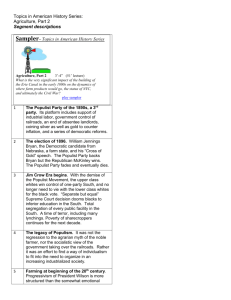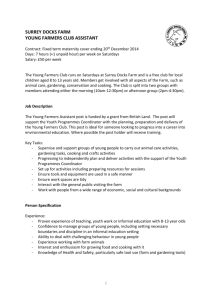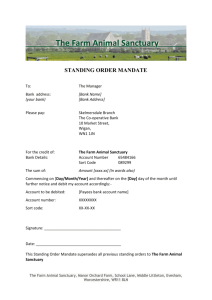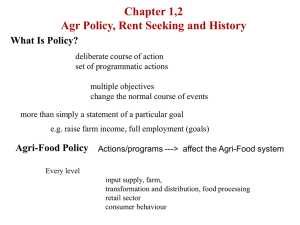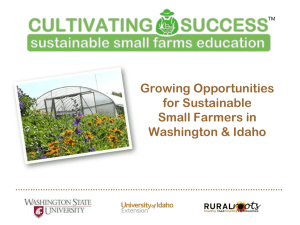NATIONAL FARM SAFETY WEEK
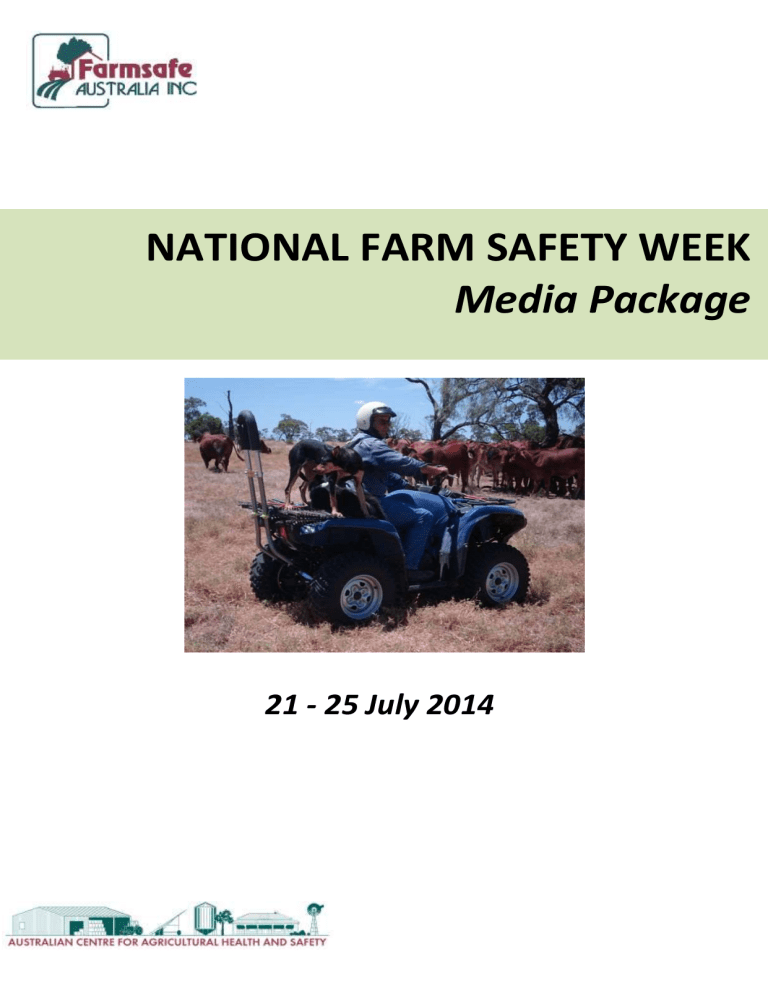
NATIONAL FARM SAFETY WEEK
Media Package
21 - 25 July 2014
CONTENTS
INTRODUCTION
About Farmsafe Australia
Farmsafe Australia Members
Farmsafe Australia Contacts
MEDIA RELEASES
Safe Farms - Healthy Farmers
Child Safety - A Great Investment At Any Time
Quads - Time for everyone to take action
FARM SAFETY - A core priority
Quads
Children
3
4
4
5
9
10
6
7
8
National Farm Safety Week Media Resource Package 21-25 July 2014 2
INTRODUCTION
National Farm Safety Week aims to raise awareness of farm safety issues in rural communities across Australia. This year’s theme for Farm Safety Week is ‘Safe Farms - Healthy Farmers’ and seeks to focus on the practical issues that farmers can take to improve safety for themselves, their workers, family members and farm visitors.
Practical steps that farmers can take to have safety as a core value include:
Having a safety plan in place that identifies potential hazards and taking specific actions to fix these.
Always be on the look-out for new hazards and fixing these as soon as possible once identified.
Setting clear safety procedures for risky work.
Making sure everyone that works on the farm understands and uses the safety procedures you have for your farm.
Having an emergency plan in place in case there are any incidents.
Over the last 20 years there has been a significant reduction in farm fatalities from a yearly average of 146 deaths to 59 in 2013.
In 2013, quads and tractors were the leading cause of non-intentional farm injury death, accounting for 40% of all cases. This year alone to June 30 we have already seen 23 tragic deaths on-farm, with quads again topping the list with six fatal cases (in addition to one other off-farm).
Included in this package are fact sheets and media releases that have been provided as a guide for
Farmsafe Groups and the media to use as they see fit. We also attach a Guide for the Media on how to demonstrate best practice safety on-farm.
Further information is available by contacting Farmsafe on 02 6752 8218 or via email teresa.munro@sydney.edu.au
National Farm Safety Week Media Resource Package 21-25 July 2014 3
3.
ABOUT FARMSAFE AUSTRALIA
Farmsafe Australia is committed to achieving improved health and safety on Australian Farms.
MISSION
“To improve the wellbeing and productivity of Australian agriculture through enhanced health and safety awareness and practices”
PHILOSOPHY
Programs and activities of Farmsafe Australia are based upon the philosophy that the key responsibility for farm safety rests primarily with individual farmers, farm families and farm workers.
Farming communities need improved knowledge and practical safety solutions in farm health and safety to reduce the risk of injury and illness associated with agricultural production.
Government and other agencies have important roles in supporting farmers to improve health and safety through establishment of relevant and appropriate mechanisms to identify and define common risks and their control.
The wider rural community can assist in facilitating farm safety action through the development of a “safety culture” in rural communities and their networks that support farmers and their families.
3.1
Members of Farmsafe Australia
National Farmers’ Federation
Country Women’s Association of Australia
Royal Flying Doctor Service of Australia
Australian Workers Union
Department of Agriculture, Fisheries and Forestry
Safe Work Australia
Rural Industries Research and Development Corporation
Australian Centre for Agricultural Health and Safety - University of Sydney
FarmSafe New Zealand
Farmsafe Victoria
Farmsafe New South Wales
Farmsafe Northern Rivers
Farmsafe Western Australia Alliance
PASS Inc (Tas)
World Safety Organisation Collaborating Centre for Injury Prevention and Safety Promotion,
James Cook University
National Farm Safety Week Media Resource Package 21-25 July 2014 4
4.
Farmsafe Contacts
The following people can assist you in carrying out your own Farm Safety Week activities.
Farmsafe Australia 02 6752 8218 Farmsafe South Australia 02 6752 8223
John Temperley
Website: www.farmsafe.org.au
Farmsafe New South Wales 02 6752 8223
Teresa Munro
Website: www.farmsafe.org.au
Farmsafe Victoria 03 9207 5511
Patricia Murdoch
Website: www.vff.org.au
Teresa Munro
Website: www.farmsafe.org.au
Farmsafe Queensland 07 4774 0522
Jamie Cupples
Website: www.farmsafe.com.au
Proactive Agricultural Safety & Support Inc (Tas)
Anne Taylor
Website: www.pass.org.au
03 6398 6212
Farmsafe WA Alliance 08 9359 4118
Sheila Payne
Website: www.farmsafewa.org
National Farm Safety Week Media Resource Package 21-25 July 2014 5
“Safe Farms - Healthy Farmers”
Media Release
This years theme for Farm Safety Week is ‘Safe Farms - Healthy Farmers’ and targets practical issues that farmers can take to improve safety and health for themselves, their workers and family members. A free phone app has also been released to help farmers with safety inductions for new workers on their farm.
“Farm safety is something that we often take for granted, of course no one wants to be injured or see others injured” said Farmsafe Australia chairman Charles Armstrong. “As an industry we have been improving our safety record, with reductions in the number of farm injury deaths approaching 65% over the past two decades. However, we still need to do more.”
“Having safety as a major aspect of our business will not only reduce risks to those that work and live on our farms, it will also improve our bottom line. Even non-fatal injuries can have major cost implications on things such as delays in harvest, damage to equipment and downtime needed to recover from injuries.”
“The new free farm safety induction app is one important step to improving safety. Farmers can work through the induction with one or more new workers. When completed, a record of the induction and what it covered is emailed to both the farmer and the worker. It’s a big step in making the process of safety induction and record keeping easier.”
Other practical steps that farmers can take to have safety as a core value include:
Have a safety plan in place that identifies potential hazards and take action to fix these.
Always be on the look-out for new hazards and fix these as soon as possible once identified
Set clear safety procedures for risky work
Make sure everyone that works on the farm understands and uses the safety procedures you have
Have an emergency plan in place in case there are any incidents
“We want farming to be both profitable and safe, and we can do both if safety is promoted as a core value for your business” stated Charlie. “It’s about making sure that everyone involved in the farm gets home safe and sound at the end of each working day. That’s a good thing not just for our families but also our business and communities.”
Key Facts - Deaths on farms (Jan 1 - June 30, 2014)
Total number of deaths = 23
Quads = 6
Tractors = 4
Farm utes = 3
Children = 2
Further information on the free new safety induction app and Farm Safety Week can be found at: www.farmsafe.org.au or by contacting the Australian Centre for Agricultural Health and Safety (02) 6752
8210 or your state Farmsafe group.
Media Contact: Charles Armstrong - 0427 265 337
Embargo Date: July 14, 2014
Media Release
Child Safety - A Great Investment At Any Time
“As farmers our most precious gift is our children” said Charles Armstrong Chairman of Farmsafe Australia.
Tragically too many children are injured or even worse killed on our farms each year. “We really want all farmers to be pro-active and take the steps that we know can protect our future farmers.”
Nationally about 20% of on-farm injury fatalities are to children under 15 years of age and there are many times more injuries each year, some with lifelong consequences. By far the biggest risk is drowning, especially for children younger than 5 years of age. However, other major issues include quads, machinery and vehicles.
“There are very clear things we can do to protect our children, its not about wrapping them up in cotton wool, but it is about taking sensible steps to reduce the chance of things going wrong” stated Charles. “A key area for all farms is to have a secure safe play area for children under 5 years. Whether you are parents of young children, a grandparent or simply have kids visiting on your property every now and then, a secure play area is a must. Tragically, around 30% of the child deaths on Australian farms over the past 10 years have been to farm visitors.”
“Quads are also a disturbing feature affecting children and we are pleading with parents to ensure that children under 16 years don’t ride or be carried as passengers on quads of any size. Last year we had two children killed and already this year we have had a further two. Put simply the risk is not worth it, as kids don’t have the physical size, strength, coordination and emotional maturity to safely operate such a dangerous piece of equipment.”
The Royal Australian College of Surgeons in addition to other international medical organisations in
Canada and the USA, all indicate that quads of any size should not be ridden by children under 16 years.
This is based on their direct knowledge of the injuries and harm that they see in hospitals.
“Of course we want to develop in our kids a love of the land and all things agricultural, but if you want them to help out, put them on a two wheeler, make sure it’s the right size for them, that they have a helmet and other protective gear and are trained and supervised. Yes they may still come a cropper, but the chances of serious injury or worse are far less, as two wheelers don’t crush or asphyxiate riders when they roll.”
“The two things you can do straight away for young children that may live or visit your farm is to make sure you have a secure safe play area and not to allow children on quads. This may not make you popular but sometimes as the expression goes, you need to be ‘cruel to be kind’. Nobody likes to see children in these incidents, so let’s fix these issues for everyone.”
Further information on child safety including safe play areas and quad safety can be obtained from the
Australian Centre for Agricultural Health and Safety (02 6752 8210) or by visiting the website www.aghealth.org.au
Media Contact: Tony Lower - 02 6752 8210
Embargo Date: July 14, 2014
Media Release
Quads - Time for everyone to take action
Between 2001 and 2013, there have been over 190 quad deaths. In 2013 alone, there were 20 fatal incidents with at least 15 occurring on-farm. To date in 2014, we have seen seven deaths including six on-farm incidents.
“In the past two years quads have overtaken tractors as the leading cause of on-farm fatal injury and tragically this appears to be continuing this year. We know that over half of these deaths result from the machines rolling over. Too many people are being asphyxiated or crushed to death” said Charles
Armstrong Chairman of Farmsafe Australia. “And this is not to mention the serious and life-changing non-fatal injuries that are all too frequent”.
Key Facts - Deaths on quads 2001-14
Total number of deaths = 190+
Rollovers are involved in 60% of fatal incidents
Overall 82% of rollover deaths occurred on a farm
Children account for around 20% of these deaths and quads of all sizes (including those made for kids) have been involved in child deaths. NO CHILD under 16 years should ride a quad of any size as they don’t have the skills to handle such dangerous equipment.
“Quads have an illusion of stability and people often think that four wheels are safer than two wheels.
This is simply not the case. Because of their instability, quads are often not the best or safest vehicle for the jobs that need to be undertaken on the farm.” stated Charles.
“In many cases a small ute, side by side vehicle or two wheel motorbike will be a better alternative and while these carry their own risks, we know they are lower than that of quads. In fact many farmers have moved away from using quads at all because the risk of rollover is too high.”
If using a quad, a key to reducing the number of deaths from rollovers is fitting a suitably tested crush protection device (CPD). The available evidence strongly supports the use of these devices, with around
8-10,000 in use across Australia and New Zealand. These devices will limit people being crushed by quads when they do rollover and have been recommended by all state Work Health Authorities in the Trans-
Tasman quad safety strategy. The CPDs are lightweight , can be fitted to most bike models through a simple tow ball fitting and don’t interfere with normal riding practices.
“Fitting these devices will save lives and prevent many serious injuries in the event of a rollover. Whether riders have lots of experience or are novices, CPDs make quads safer. We also reinforce the message that all owners and operators of quads should keep children under 16 off quads of all sizes, never carry passengers, ensuring training / supervision, work within load limits and wear a helmet.”
Further information on quad bike safety can be obtained from the Australian Centre for Agricultural
Health and Safety (02 6752 8210) or by visiting the website www.aghealth.org.au
.
Media Contact: Tony Lower - 02 6752 8210
Embargo Date: July 14, 2014
Safe
Farms - Healthy Farmers
Quads
What are the hazards and risks?
The common risks are caused by riders losing control, collision, quad rollover, carrying passengers and loads and riders under 16 years of age. This can result in:
Death of riders and passengers from collision, being thrown from the quad or being crushed/asphyxiated during rollover
Serious injury resulting in permanent injury or disability
Who is at risk?
The people at risk of injury while driving or riding quad are:
All quad riders
People being carried as passengers
Operators under 16 years of age on any sized quad
What needs to be done to keep people safe?
These are rules and ways of making sure people are safer while operating quads:
Choosing whether the quad is the safest machine for the job
Fit a Crush Protection device to prevent injury during rollover
Only operate quads that are in good repair. Do a pre-operation safety check, especially brakes and tyre pressure
Only ride a quad if you have been properly trained
Do not let anyone under 16 years old operate a quad of any size
Do not carry passengers
Making sure that the quad is not overloaded
Only ride the quad on farm tracks and areas that have been identified as safe
All operators are to wear a helmet
Key Facts - Deaths on quads 2001-14
Total number of deaths = 190+
Rollovers are involved in 60% of fatal incidents
Overall 82% of rollover deaths occurred on a farm
Risk s are high for both adult and allegedly “child sized” quads
Children account for around 20% of these deaths and quads of all sizes (including those made for kids) have been involved in child deaths. NO CHILD under 16 years should ride a quad of any size as they do not have the physical size, strength, coordination and emotional maturity to handle such a dangerous piece of equipment. This is also the stated position of the Royal Australasian College of Surgeons and many other credible medical agencies.
Children on Farms
Safe
Farms - Healthy Farmers
What are the hazards and risks?
The common risks are toddlers wandering off, children playing unsupervised where work is being done, children being taken into shearing sheds, cattle yards, riding on tractors, farm machinery or riding unrestrained on the back of utes and in vehicles. This has resulted in:
toddlers drowning
children falling off or being crushed by quads
children being crushed by livestock
children being entangled and run over by tractors, vehicles and farm machinery
children falling off the back of moving utes and being injured during motor vehicle crashes
Who is at risk?
All children living and visiting farms.
What needs to be done to keep children safe?
There are rules and ways of making sure children are not injured or die on farms, such as:
Creating a ‘Safe Play Area’ - a securely fenced yard with self latching gate to prevent toddlers wandering away unsupervised and being run over or drowning in farm dams, troughs and creeks.
Don’t leave keys in parked vehicles, tractors and machinery
Supervise children on farms when they accompany parents when work is being done
DO NOT carry children as passengers or allow children to operate or ride quads of any size
DO NOT carry children as passengers or allow children to ride on tractors and farms machinery
Make sure all children and passengers are wearing seatbelts in farm vehicles
Not carry or allow children to ride unrestrained in the back of farm utes
Wear helmets when riding horses and farm motorbikes
Key Facts - Child injury deaths on farm
In 2013, 10 of the 59 on-farm injury deaths (17%) were to children with quads and drowning accounting for 40% of these.
The two child on-farm injury deaths thus far in 2014 have involved quads
Around 30% of child deaths involve visitors to the farm

